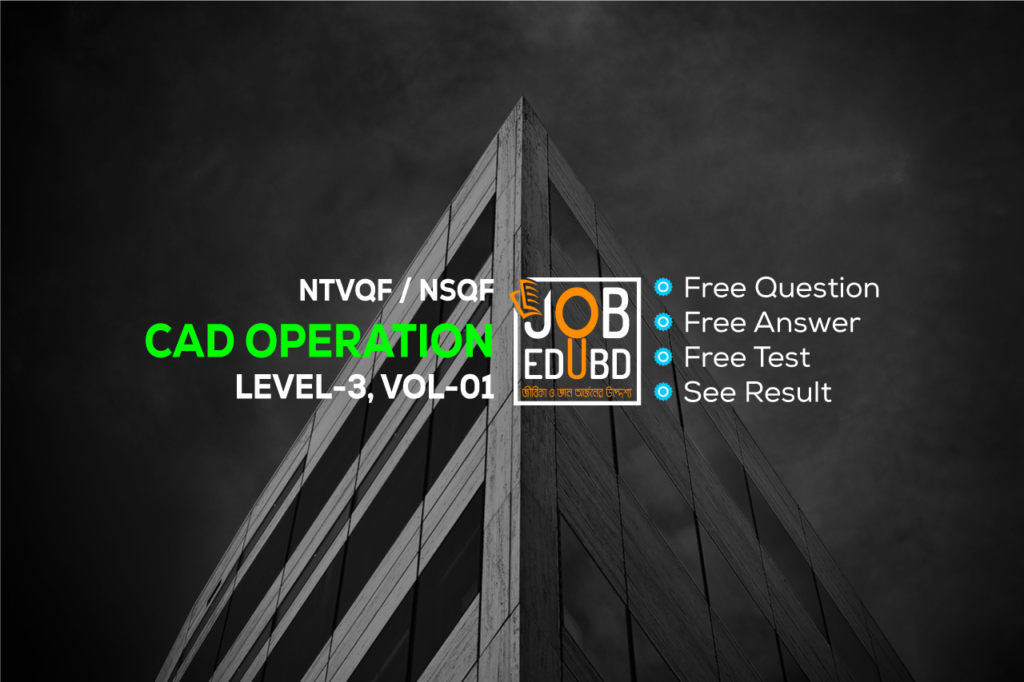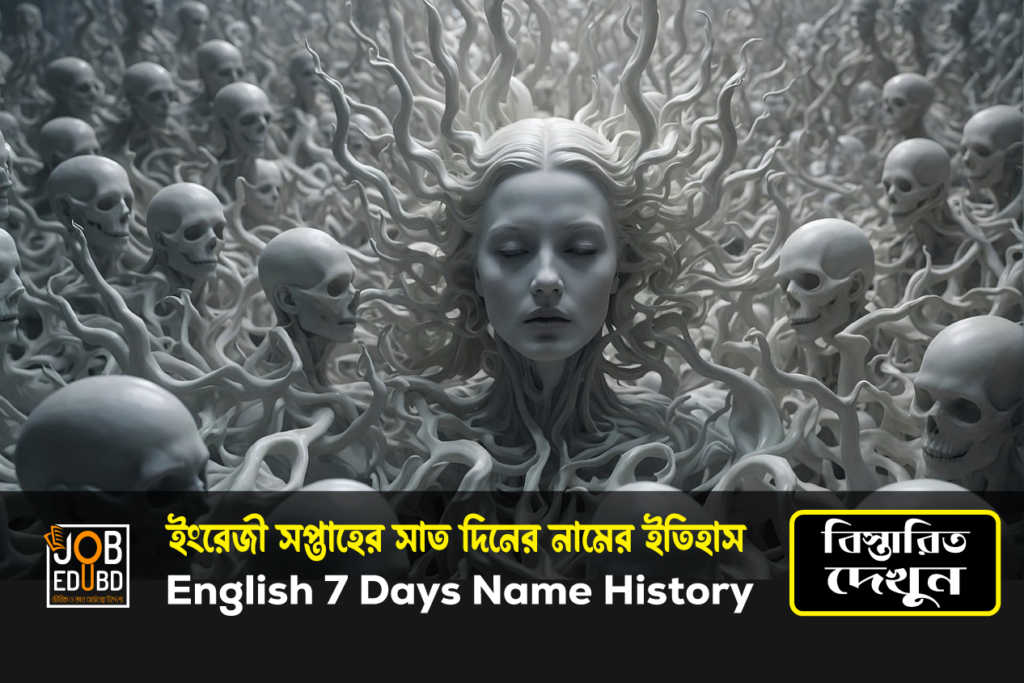Graphic Design Level-3 Suggestion V-5
Written Test Graphic Design Level-3 Suggestion V-5 by Job Edu BD
First, test yourself with the following MCQs, if you can’t do it, you can check the answer by clicking on the answer button.
Graphic Design level-3 Suggestion V-5
01. What does the A in RGBA stand for??
- Alpha-Numerical
- Aliasing
- Alpha
- Opacity
02. How many digits are in a hexadecimal color code??
- 4
- 6
- 8
- 3
03. Which of the following describes “anti-aliasing”?
- Removal of errors and bad pixels from a low-res image.
- A smooth edge or transition of pixels around a graphic, so it’s not jagged.
- Editing to take out the image’s EXIF data.
- A rough placeholder graphic that will be replaced before printing with a high res version.
04. What would you call a grayscale image when printing off set??
- Halftone art
- Split fountain art
- Line art
- Color art
05. Photoshop is a product of -?
- Mac
- Adobe
- Macromedia
- Apple
06. Raster\Which of the following is considered the industry standard for photo manipulation in graphic design?
- Dreamweaver
- Paint
- Photoshop
- Acrobat
07. Which type of graphic can be infinitely rescaled \Without loss of resolution?
- Vector
- Pointilated
- Pixelated
- Rasterization
08. What color does the “K” in CMYK stands for?
- Blue
- Black
- Magenta
- Red
09. Which statement of the following is the best describes Photoshop and Illustrator?
- Photoshop is web, Illustrator is print
- Photoshop is CMYK, Illustrator is Monotone
- Photoshop is raster, Illustrator is vector
- Photoshop is vector, Illustrator is raster
10. HSL, one of the color-control options often found in software stands for:
- Hue, Saturation, Lightness
- Hue, Softness, Lightness
- Highlights, Saturation, Lowlights
- Height, skin tone, language
11. What is a watermark?
- A translucent mark that is mostly only visible when held up to light
- A stain that accidentally happens during printing
- Where the paper cutter will trim the page
- A special plate the embosses plastic into paper
12. Which one of the following does not stand f or typographic hierarchy?
- Placement
- Contrast
- Point size
- Depth of field
13. Which of the following terms is use for describing the resolution Of an image?
- Time, Space. Or Di Tant.
- Pixels, Dots, Or Lines Per Inch.
- Height, Weigl1t, Or Length.
- Feet, Inches, Or Yards.
14. Which one of the following is a serif font?
- Century Gothic
- Arial
- Georgia
- Time new Roman
15. What is typography in graphic design?
16. What is a logo design?
17. What is kerning?
18. How do I find graphic design clients as a freelancer?
19. What is the RGB color model used for in graphic design?
20. What is the CMYK color model used for in graphic design?
21. What is a raster image file format?
22. What is a vector image file format?
23. What is the importance of responsive design in web graphics?
24. What is the purpose of wireframes in web design?
25. What is the difference between UI and UX design?
26. What is white space in graphic design?
27. How can I improve my graphic design skills?
28. What is a brand identity?
29. What is the Pantone Matching System (PMS)?
30. What is a rasterize layer in Photoshop?
01. What does the A in RGBA stand for??
C. Alpha
02. How many digits are in a hexadecimal color code??
B. 6
03. Which of the following describes “anti-aliasing”?
B. A smooth edge or transition of pixels around a graphic, so it’s not jagged.
04. What would you call a grayscale image when printing off set??
A. Halftone art
05. Photoshop is a product of -?
B. Adobe
06. Raster\Which of the following is considered the industry standard for photo manipulation in graphic design?
C. Photoshop
07. Which type of graphic can be infinitely rescaled \Without loss of resolution?
A. Vector
08. What color does the “K” in CMYK stands for?
B. Black
09. Which statement of the following is the best describes Photoshop and Illustrator?
C. Photoshop is raster, Illustrator is vector
10. HSL, one of the color-control options often found in software stands for:
A. Hue, Saturation, Lightness
11. What is a watermark?
A. A translucent mark that is mostly only visible when held up to light
12. Which one of the following does not stand f or typographic hierarchy?
D. Depth of field
13. Which of the following terms is use for describing the resolution Of an image?
B. Pixels, Dots, Or Lines Per Inch.
14. Which one of the following is a serif font?
C. Georgia
15. What is typography in graphic design?
Typography refers to the selection and arrangement of fonts to convey a message or aesthetic in design.
16. What is a logo design?
A logo is a visual symbol that represents a brand, company, or organization.
17. What is kerning?
Kerning is the adjustment of space between individual characters in a font to improve readability and aesthetics.
18. How do I find graphic design clients as a freelancer?
Use online platforms like Upwork, Fiverr, or social media to showcase your work and connect with potential clients.
19. What is the RGB color model used for in graphic design?
The RGB color model is used for digital displays and combines red, green, and blue to create various colors.
20. What is the CMYK color model used for in graphic design?
The CMYK color model is used for printing and combines cyan, magenta, yellow, and black (key) to create colors.
21. What is a raster image file format?
Raster image formats include JPEG, PNG, and GIF, and they use pixels to represent images.
22. What is a vector image file format?
Vector image formats include SVG and AI, and they use paths and mathematical equations to define graphics
23. What is the importance of responsive design in web graphics?
Responsive design ensures that graphics adapt to different screen sizes and devices for a consistent user experience.
24. What is the purpose of wireframes in web design?
Wireframes are basic sketches of a web page’s layout and structure, helping plan its design and functionality.
25. What is the difference between UI and UX design?
UI (User Interface) design focuses on the visual elements of a product, while UX (User Experience) design considers the overall user journey.
26. What is white space in graphic design?
White space, or negative space, is the empty space around and between design elements, which helps create balance and clarity.
27. How can I improve my graphic design skills?
Practice regularly, seek feedback, study design principles, and stay updated on industry trends.
28. What is a brand identity?
A brand identity encompasses a brand’s visual elements, such as logos, colors, and fonts, that convey its unique personality.
29. What is the Pantone Matching System (PMS)?
PMS is a standardized color-matching system used in graphic design and printing to ensure consistent colors.
30. What is a rasterize layer in Photoshop?
Rasterizing a layer converts it into a bitmap image, which may be necessary for certain editing or effects.

MD. SALAHUDDIN
CSE, BUBT
In-Charge (Graphic Design)
Instructor
Bangladesh-German Technical Training Center
Mirpur-2, Dhaka-1216
Graphic Design Level-3 Suggestion V-3
"You will pass just by asking the mentioned questions, it's not like that at all, but chances are upto 80% to get common. This is just a suggestion. This question is not copied from any board question"
Related Post
Graphic design is a profession,[2] academic discipline[3][4][5] and applied art whose activity consists in projecting visual communications intended to transmit specific messages to social groups, with specific objectives.[6] Graphic design is an interdisciplinary branch of design[1] and of the fine arts. Its practice involves creativity, innovation and lateral thinking using manual or digital tools, where it is usual to use text and graphics to communicate visually.
The role of the graphic designer in the communication process is that of the encoder or interpreter of the message. They work on the interpretation, ordering, and presentation of visual messages. Usually, graphic design uses the aesthetics of typography and the compositional arrangement of the text, ornamentation, and imagery to convey ideas, feelings, and attitudes beyond what language alone expresses. The design work can be based on a customer’s demand, a demand that ends up being established linguistically, either orally or in writing, that is, that graphic design transforms a linguistic message into a graphic manifestation.[7]
Graphic design has, as a field of application, different areas of knowledge focused on any visual communication system. For example, it can be applied in advertising strategies, or it can also be applied in the aviation world[8] or space exploration.[9][10] In this sense, in some countries graphic design is related as only associated with the production of sketches and drawings, this is incorrect, since visual communication is a small part of a huge range of types and classes where it can be applied.
COPY
Graphic design has, as a field of application, different areas of knowledge focused on any visual communication system. For example, it can be applied in advertising strategies, or it can also be applied in the aviation world[8] or space exploration.[9][10] In this sense, in some countries graphic design is related as only associated with the production of sketches and drawings, this is incorrect, since visual communication is a small part of a huge range of types and classes where it can be applied.
With origins in Antiquity and the Middle Ages,[11] graphic design as applied art was initially linked to the boom of the rise of printing in Europe in the 15th century and the growth of consumer culture in the Industrial Revolution. From there it emerged as a distinct profession in the West, closely associated with advertising in the 19th century[12] and its evolution allowed its consolidation in the 20th century. Given the rapid and massive growth in information exchange today, the demand for experienced designers is greater than ever, particularly because of the development of new technologies and the need to pay attention to human factors beyond the competence of the engineers who develop them.[13]
History: In both its lengthy history and in the relatively recent explosion of visual communication in the 20th and 21st centuries, the distinction between advertising, art, graphic design and fine art has disappeared. They share many elements, theories, principles, practices, languages and sometimes the same benefactor or client. In advertising, the ultimate objective is the sale of goods and services. In graphic design, “the essence is to give order to information, form to ideas, expression, and feeling to artifacts that document the human experience.”[17]
The definition of the graphic designer profession is relatively recent concerning its preparation, activity, and objectives. Although there is no consensus on an exact date when graphic design emerged, some date it back to the Interwar period. Others understand that it began to be identified as such by the late 19th century.[11]
It can be argued that graphic communications with specific purposes have their origins in Paleolithic cave paintings and the birth of written language in the third millennium BCE. However, the differences in working methods, auxiliary sciences, and required training are such that it is not possible to clearly identify the current graphic designer with prehistoric man, the 15th-century xylographer, or the lithographer of 1890.
The diversity of opinions stems from some considering any graphic manifestation as a product of graphic design, while others only recognize those that arise as a result of the application of an industrial production model—visual manifestations that have been “projected” to address various needs: productive, symbolic, ergonomic, contextual, among others.
Nevertheless, the evolution of graphic design as a practice and profession has been closely linked to technological innovations, social needs, and the visual imagination of professionals.[18] Graphic design has been practiced in various forms throughout history; in fact, good examples of graphic design date back to manuscripts from ancient China, Egypt, and Greece. As printing and book production developed in the 15th century, advances in graphic design continued over the subsequent centuries, with composers or typographers often designing pages according to established type.[11]
By the late 19th century, graphic design emerged as a distinct profession in the West, partly due to the process of labor specialization that occurred there and partly due to the new technologies and business possibilities brought about by the Industrial Revolution. New production methods led to the separation of the design of a communication medium (such as a poster) from its actual production. Increasingly, throughout the 19th and early 20th centuries, advertising agencies, book publishers, and magazines hired art directors who organized all visual elements of communication and integrated them into a harmonious whole, creating an expression appropriate to the content. In 1922, typographer William A. Dwiggins coined the term graphic design to identify the emerging field.[11]
Throughout the 20th century, the technology available to designers continued to advance rapidly, as did the artistic and commercial possibilities of design. The profession expanded greatly, and graphic designers created, among other things, magazine pages, book covers, posters, CD covers, postage stamps, packaging, brands, signs, advertisements, kinetic titles for TV programs and movies, and websites. By the early 21st century, graphic design had become a global profession as advanced technology and industry spread worldwide.[11]
Graphic design can have many applications, from road signs to technical schematics and reference manuals. It is often used in branding products and elements of company identity such as logos, colors, packaging, labelling and text.
From scientific journals to news reporting, the presentation of opinions and facts is often improved with graphics and thoughtful compositions of visual information – known as information design. With the advent of the web, information designers with experience in interactive tools are increasingly used to illustrate the background to news stories. Information design can include Data and information visualization, which involves using programs to interpret and form data into a visually compelling presentation, and can be tied in with information graphics.
Skill: A graphic design project may involve the creative presentation of existing text, ornament, and images.
The “process school” is concerned with communication; it highlights the channels and media through which messages are transmitted and by which senders and receivers encode and decode these messages. The semiotic school treats a message as a construction of signs which through interaction with receivers, produces meaning; communication as an agent.[citation needed]
Typography
Typography includes type design, modifying type glyphs and arranging type. Type glyphs (characters) are created and modified using illustration techniques. Type arrangement is the selection of typefaces, point size, tracking (the space between all characters used), kerning (the space between two specific characters) and leading (line spacing).
Typography is performed by typesetters, compositors, typographers, graphic artists, art directors, and clerical workers. Until the digital age, typography was a specialized occupation. Certain fonts communicate or resemble stereotypical notions. For example, the 1942 Report is a font which types text akin to a typewriter or a vintage report.[36]
From Wikipedia, the free encyclopedia
Post review
Finding Your Post
Graphic Design Level-3 Suggestion V-5 NSQF / NTVQF CAD Operation Level-3 Suggestion V-4, NSQF NTVQF, CAD Operation Level-3 Suggestion V-4, Job Edu BD, NSQF NTVQF NSDA BTEB Suggestion Vol-1
Graphic Design Level-3 Suggestion V-5 NSQF / NTVQF CAD Operation Level-3 Suggestion V-4, NSQF NTVQF, CAD Operation Level-3 Suggestion V-4, Job Edu BD, NSQF NTVQF NSDA BTEB Suggestion Vol-1 NSQF NTVQF NADA BTEB Graphic Design Level-3 Suggestion V-5
Graphic Design Level-3 Suggestion V-5 NSQF / NTVQF CAD Operation Level-3 Suggestion V-4, NSQF NTVQF, CAD Operation Level-3 Suggestion V-4, Job Edu BD, NSQF NTVQF NSDA BTEB Suggestion Vol-1 NSQF NTVQF NADA BTEB Graphic Design Level-3 Suggestion V-5







